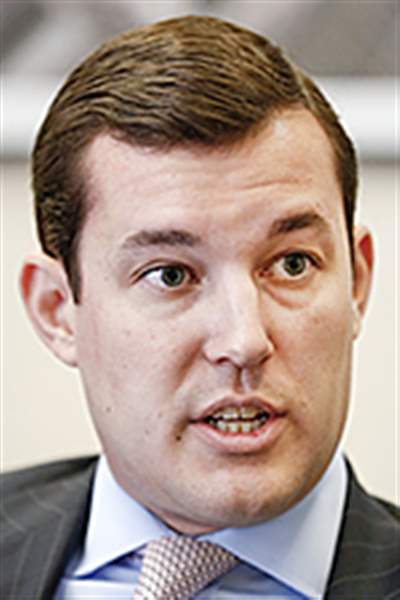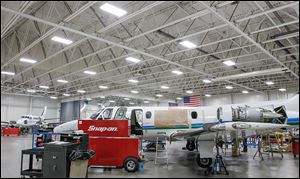
TOLEDO EXPRESS
Treece study just latest look at airport potential
Family exploring fringe aviation business
12/22/2013
Dock David Treece
THE BLADE
Buy This Image

Toledo Jet Center rose in place of a Cessna maintenance facility that went out of business four years ago. Two shifts of mechanics work seven days a week there.
The quest to recommercialize Toledo Express Airport has generated piles of research by the Toledo-Lucas County Port Authority, with heavy emphasis on the big producers of jobs and revenue — air freight and passengers — but little on the fringe aviation businesses that the local Treece family is advocating.
The Treeces — a father and two sons who run an investment advising business but who lack airport expertise — are mounting an effort to take over and operate the 2,600-acre facility.
Dock Treece, 63, and sons Dock David Treece, 26, and Benjamin Treece, 25, partners in the Treece Investment Advisory Corp. of Sylvania Township, commissioned an 86-page “marketability study” aiming to propose new ways of making money at Toledo Express.
The Treece report explored general aviation, or private and corporate travel; scheduled or on-demand jet charter services largely geared to business travelers; maintenance, repair, and overhaul facilities; aircraft manufacturing and painting; flight training; an air industrial park, and defense contracting, among other ideas.

Dock David Treece
Port authority officials largely scoffed at the study when it came out two weeks ago, commenting that there was nothing in its pages that they had not already studied or tried.

Paul Toth
The Treece marketability study offers only a few pages of analysis of the potential for expanding cargo handling and commercial passenger aviation at Toledo Express, some of it pointing out the obvious, such as “Air cargo trends have been somewhat stagnant in recent years as it is closely tied to the overall economy.”
For a closer look at studies and reports conducted or acquired by the Toledo-Lucas County Port Authority, click here.
To review the Treece airport marketability study, click here.
By contrast, studies conducted by the port authority over the last four years supply page after page of dense detail, with such industry minutiae as the “pavement strength” of Toledo’s runways compared with that of other airports.
A Blade review of the Treece study suggests that the Treeces’ consultant, Airport Business Solutions of Tampa, Fla., hit upon some potential new activities that have never been formally studied by the Toledo-Lucas County Port Authority.
Whether those businesses merit closer examination is a question asked by port officials.
But Dock David Treece, the son heading up the airport proposal, contends the port authority is stuck in the past, hung up on a business model, air freight, that no longer fits the economy.
“People remember years and years ago a number of airlines serving this airport. People don’t necessarily think about the changes in the cargo and passenger service since their respective heydays. That’s where the port authority focused their attention since that’s where the airport had some notable success for years,” said Mr. Treece, who is known as Dock 2.
Mr. Treece said the Treece airport plan is not an attack on the port authority, which he said has done some good things, such as brownfield redevelopment, but rather a claim that a private enterprise could run the airport operations more profitably than a large public entity.
Past studies
The port authority has spent its money on studying the big enchiladas of the airport industry — passenger carrying and cargo handling:
■ The 2013 True Market Study, a 55-page report produced in March by the port board’s consultant, Sixel Consulting Group Inc. of Eugene, Ore., that is chock-full of charts detailing how many people in four counties surrounding Toledo Express use aviation and to which cities they fly.
■ A 38-page study in February, 2012, that laid out the case for Frontier Airlines to set up service out of Toledo to Denver, with connections to airports in the West. That study envisioned 650 passengers a day on Frontier out of the Toledo area. Frontier never bit.
■ The airport’s 95-page master plan that is dominated by one subject: logistics and air cargo transportation. Its completion in 2009 sparked a port authority venture into warehousing and distribution that gave it the confidence to develop a $2 million industrial air park on the south side of the airport, with an 80,000-square-foot building, now leased. That master plan also justified the port authority’s risk-taking at the former Jeep Parkway plant where the port is converting the old industrial site into a warehouse and distribution center.
■ Air Service Development Plans, completed in 2011 and 2012, which spell out a strategy to recruit airline service to the community that has a reasonable chance of being sustainable.
Citing successes
Paul Toth, Jr., president of the Toledo-Lucas County Port Authority, disagreed that the port authority has missed business opportunities. In fact, he said the decline of air freight and the intense competition for passenger service — both brought on by high jet fuel prices — have forced the port authority to broaden its net and to find ways of saving money.
“We put every effort we possibly can put to make it happen,” Mr. Toth said. “Most of our focus over the last several years has been working with smaller businesses.”
Examples of such successes, indeed, may not be well known to Toledoans:
■ A one-plane cargo operation called Northern Air Cargo operates with a single 737 — a far cry from the 20 flights a night that used to come and go at Toledo Express.
“They’ve bought a lot of fuel from the [fixed-based operators), they’ve brought a lot of cargo in and out of here, this is their base of operation, their pilots now live in Toledo — they used to be down in Texas,” Mr. Toth said.
■ Sierra West Airlines, based in Oakdale, Calif., which has 17 smaller airplanes, recently signed a new 30-year lease.
“We consider them to be as much of a success story as landing a new airline,” said Mr. Toth, who hosted a tenant appreciation lunch at the airport on Thursday.
■ Toledo Jet Center rose in place of a Cessna maintenance facility that went out of business four years ago and was aided by generous leasing terms from the port. Since then, the owner has had two shifts of mechanics working seven days a week and has opened a second site in Fort Lauderdale, under the shingle Toledo Jet Center.
Amateurs at work
Michael Boyd, president of Boyd Group International, based in Evergreen, Colo., an airline industry analyst and consultant who has worked on Toledo service development in the past, agreed that the Treece study does not provide a detailed basis for any new business at the airport. He said many of its findings are obvious.
“That report meant nothing. That wasn’t an analysis of anything,” Mr. Boyd said.
He said it showcases the Treeces as well-meaning amateurs — though he said it’s good news for Toledo that someone in the local business community is publicly raising the issue of the viability of the airport.
That being said, Mr. Boyd said circumstances don’t favor a big passenger or cargo revival at Toledo. He said the fact is that Detroit is Toledo’s passenger airport, and the cargo industry is “moribund.”
“We have new freighters coming off the line at Boeing and going right to the desert,” Mr. Boyd said.
Ups and downs
Owned by the city of Toledo, Toledo Express Airport opened in 1955 largely at the behest of a large group of local corporations that called Toledo home. Toledo ran the airport until 1973, when it was leased at $1 a year to the port authority. The port authority has taken total responsibility for the airport from the city, even absorbing the more than $500,000 in deficits that cropped up in 2011 and 2012.
Since those heady days, many of Toledo’s Fortune 500 companies have closed or been bought out and, in any case, most area businesses prefer the low fares and huge selection of flights out of Detroit Metropolitan-Wayne County Airport to the cost of maintaining a corporate jet.
While passenger service has struggled, the airport has had success as a cargo hub — until the high cost of jet fuel drove shippers to prefer trucks and trains.
In 1991, Toledo Express landed a lucrative business opportunity when then-Burlington Air Express moved from Fort Wayne, Ind. Burlington and its successor, BAX Global, employed up to 800 people and generated $14 million in net revenues for the airport in just its last decade of operation before its September, 2011, closing.
Also helping to sustain the airport is the 180th Fighter Wing of the Ohio Air National Guard, which local officials proudly say is one of the best, if not the best, installation of its kind.
Mr. Toth, 48, who was airport director from 2000 to 2007 and became port president in 2009, said the port authority has data that cast light on the kinds of businesses the Treeces say they would try.
“Why would I spend the money when I already know what the data is telling me,” Mr. Toth asked.
Wait and see
So far, the Treeces have placed some general information about their plan and their marketability study on their Web site, www.toledoairports.com, with promises to release more in 2014.
Dock David Treece said a detailed business plan will be forthcoming in the new year.
“We’re going to wait to see what happens after the mayor [D. Michael Collins] takes office and after the new City Council takes office and see if there is interest in gathering letters of interest or putting out requests for proposal,” Mr. Treece said. “One way or the other a business plan will be made public. People in this area are going to know what opportunities we are interested in taking a look at.”